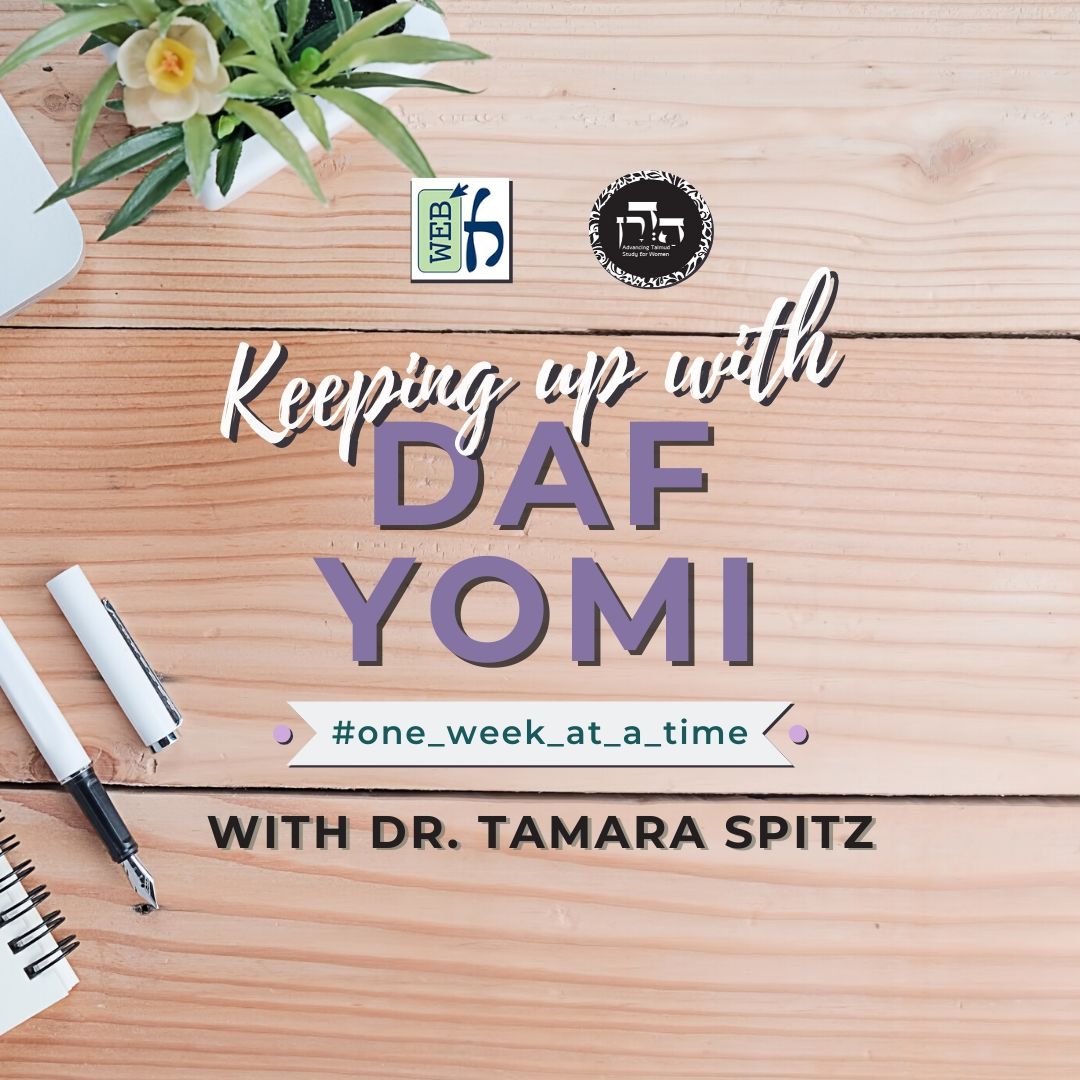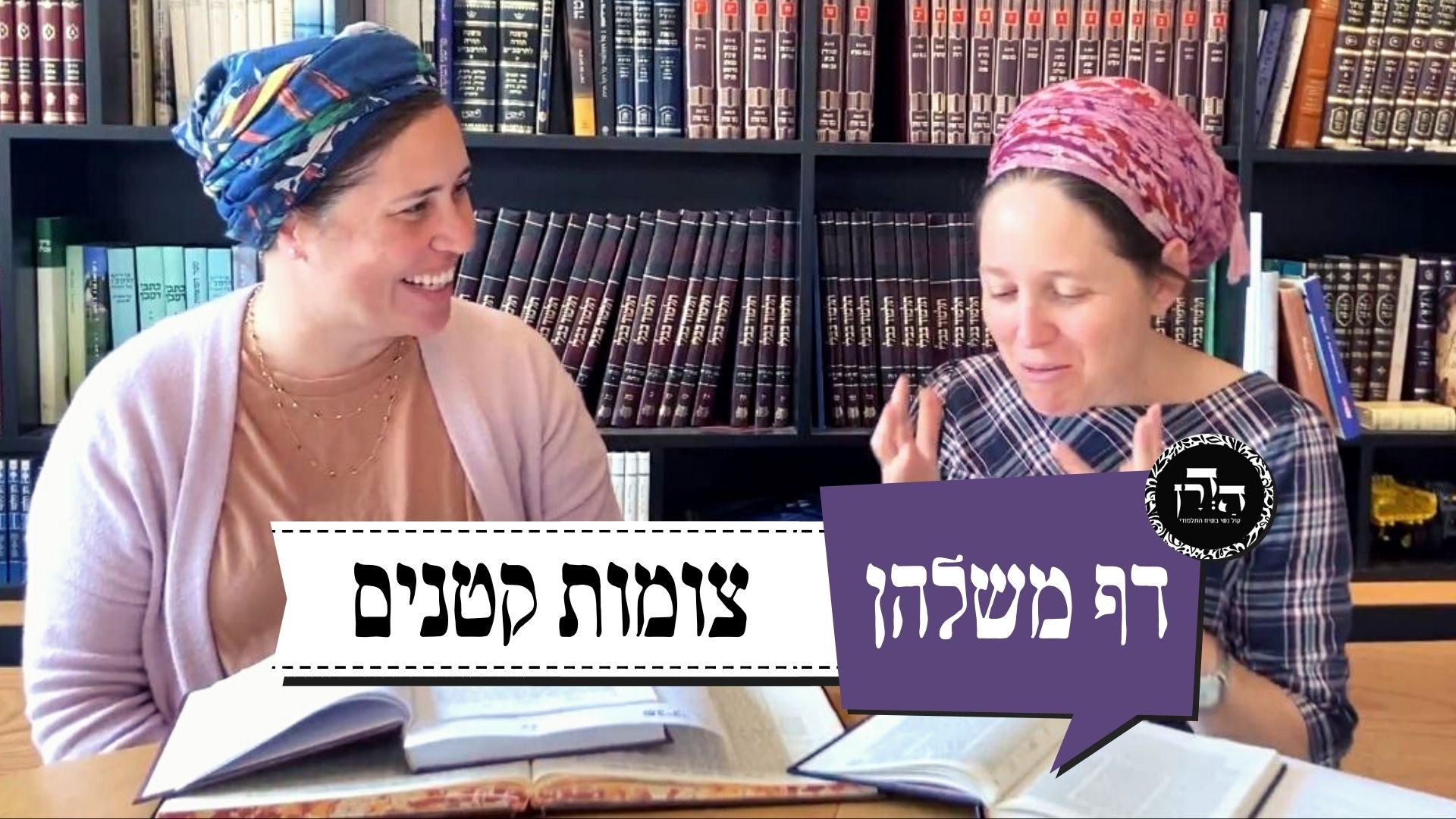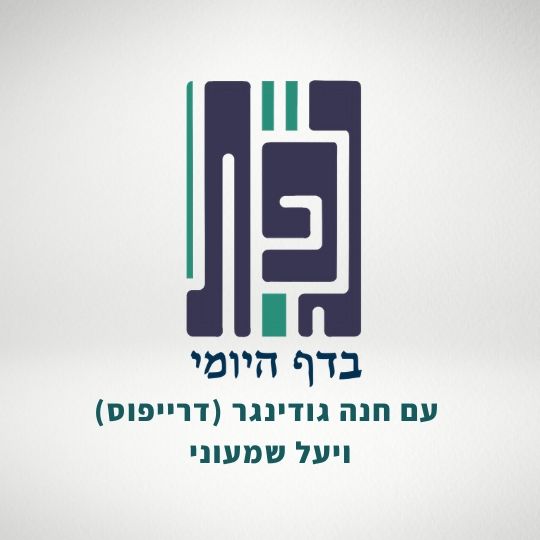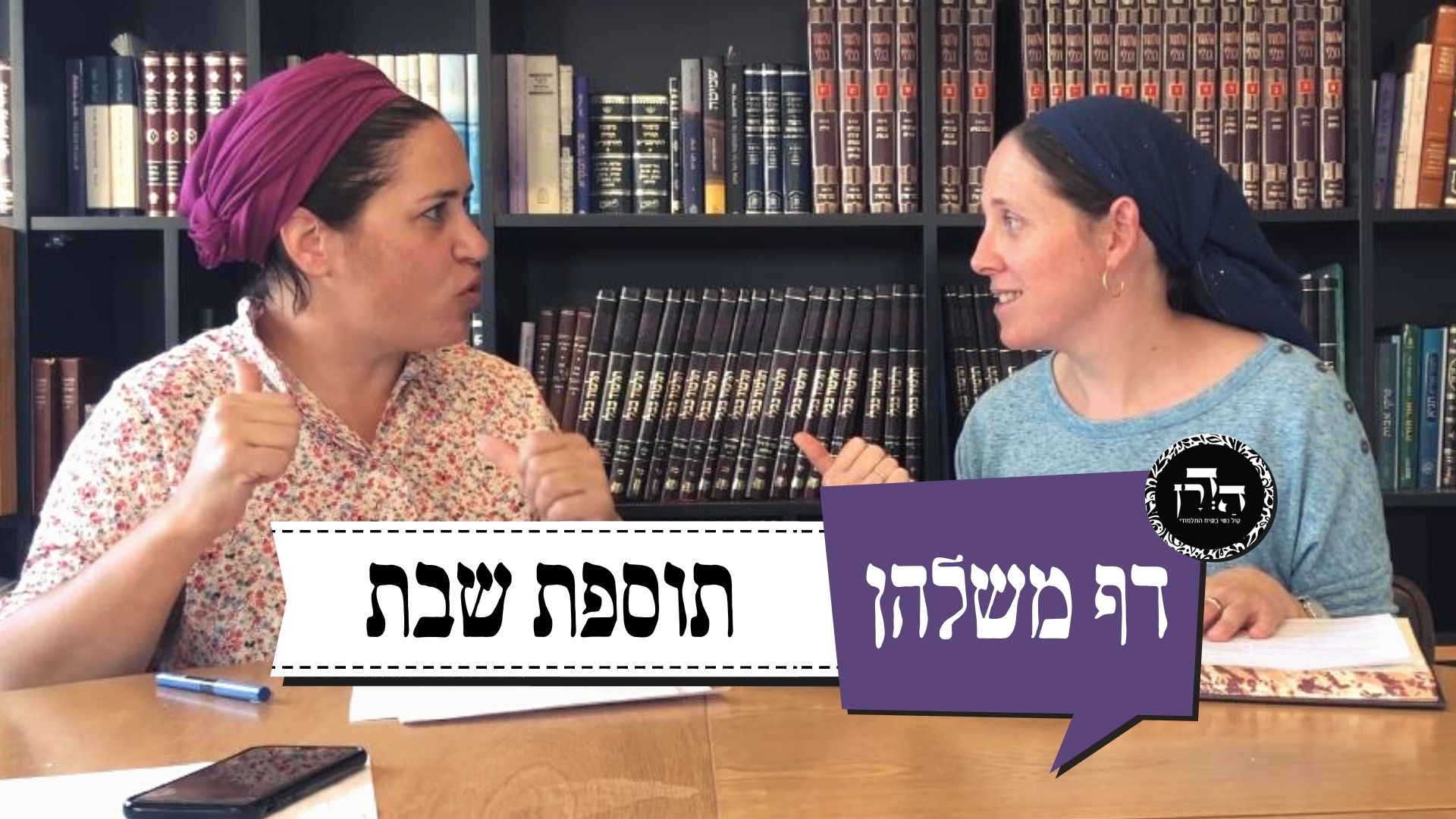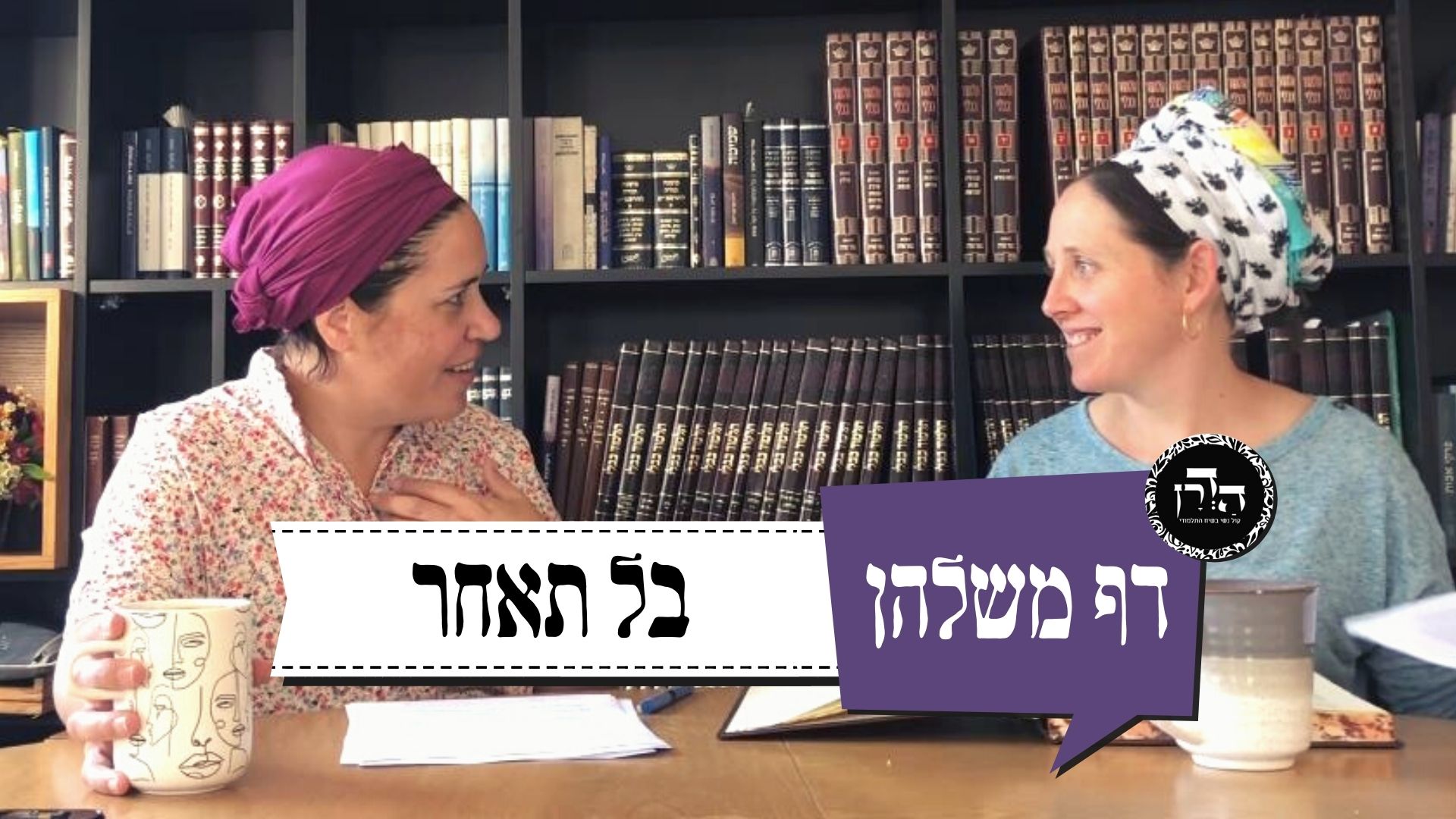ראש השנה כז
וּפִיו מְצוּפֶּה זָהָב. וְהָתַנְיָא: צִיפָּהוּ זָהָב בִּמְקוֹם הַנָּחַת פִּיו — פָּסוּל, שֶׁלֹּא בִּמְקוֹם הַנָּחַת פִּיו — כָּשֵׁר! אֲמַר אַבָּיֵי: כִּי תְּנַן נָמֵי מַתְנִיתִין — שֶׁלֹּא בִּמְקוֹם הַנָּחַת פֶּה תְּנַן.
§ It was taught in the mishna: And the mouth of the shofar that was used on Rosh HaShana was plated with gold. The Gemara raises a difficulty: But isn’t it taught in a baraita: If a shofar was plated with gold at the place where one puts his mouth, it is unfit for blowing; if it was plated, but not at the place where he puts his mouth, it is fit for blowing? Abaye said: When we learned in the mishna as well, we learned that it referred not to the place where one puts his mouth, but a little above it.
וּשְׁתֵּי חֲצוֹצְרוֹת מִן הַצְּדָדִים. וּתְרֵי קָלֵי מִי מִשְׁתַּמְעִי? וְהָתַנְיָא: ״זָכוֹר״ וְ״שָׁמוֹר״, בְּדִיבּוּר אֶחָד נֶאֶמְרוּ, מַה שֶּׁאֵין הַפֶּה יְכוֹלָה לְדַבֵּר וְאֵין הָאוֹזֶן יְכוֹלָה לִשְׁמוֹעַ! לְכָךְ מַאֲרִיךְ בְּשׁוֹפָר.
§ It was taught in the mishna: And there were two trumpets, one on each of the two sides of the person sounding the shofar. The Gemara asks: But is it really possible to properly discern two different sounds, that of the shofar and that of the trumpets, at the same time? Isn’t it taught in a baraita: The two versions of the fifth of the Ten Commandments, “Remember the Shabbat day” (Exodus 20:8) and “Keep the Shabbat day” (Deuteronomy 5:12), were spoken by God simultaneously in a single utterance, something that the human mouth cannot speak and the human ear cannot hear? This indicates that it is impossible to take in two sounds at once, and so, due to the sound of the trumpets, it should be impossible to hear the blast of the shofar. The Gemara answers: For this reason they would sound a long blast with the shofar, to make it possible to hear the sound of the shofar on its own.
לְמֵימְרָא דְּכִי שָׁמַע סוֹף תְּקִיעָה בְּלֹא תְּחִילַּת תְּקִיעָה יָצָא, וּמִמֵּילָא: תְּחִילַּת תְּקִיעָה בְּלֹא סוֹף תְּקִיעָה יָצָא?
The Gemara rejects this answer: Is this to say that if one hears the end of a blast without hearing the beginning of the blast he has fulfilled his obligation? In this case one hears only the end of the shofar blast, since the shofar was initially sounded together with the trumpets. If so, it would follow that if one hears the beginning of the blast without hearing the end of the blast, he has also fulfilled his obligation.
תָּא שְׁמַע: תָּקַע בָּרִאשׁוֹנָה וּמָשַׁךְ בַּשְּׁנִיָּה כִּשְׁתַּיִם — אֵין בְּיָדוֹ אֶלָּא אַחַת. אַמַּאי? תִּיסְלַק לֵיהּ בְּתַרְתֵּי! פַּסּוֹקֵי תְּקִיעָתָא מֵהֲדָדֵי לָא פָּסְקִינַן.
This, however, is difficult. Come and hear that which was taught in a mishna: If one blew the initial tekia, a long, continuous shofar blast, of the first tekia-terua-tekia set, and then drew out the final tekia of that set so that it spans the length of two tekiot, it counts as only one tekia and is not considered two tekiot, i.e., the final tekia of the first set, and the initial tekia of the second set. But why is this so? Let it count for him as two tekiot, since as stated above, half a blast is considered a blast. The Gemara explains: If one hears only the beginning or the end of a shofar blast, he has indeed fulfilled his obligation, but nevertheless we do not divide a shofar blast into two.
תָּא שְׁמַע: הַתּוֹקֵעַ לְתוֹךְ הַבּוֹר אוֹ לְתוֹךְ הַדּוּת אוֹ לְתוֹךְ הַפִּיטָס, אִם קוֹל שׁוֹפָר שָׁמַע — יָצָא, וְאִם קוֹל הֲבָרָה שְׁמַע — לֹא יָצָא. אַמַּאי? לִיפּוֹק בִּתְחִילַּת תְּקִיעָה, מִקַּמֵּי דְּלִיעַרְבַּב קָלָא!
The Gemara raises another difficulty: Come and hear that which was taught in a mishna: With regard to one who sounds a shofar into a pit, or into a cistern, or into a large jug [pitas], if he clearly heard the sound of the shofar, he has fulfilled his obligation, but if he also heard the sound of an echo, he has not fulfilled his obligation. But why is this so? If half a blast is indeed considered a complete blast, let him fulfill his obligation with the beginning of the blast, before the sound is confused with the echo, since the beginning of the blast was heard clearly.
אֶלָּא: תַּרְתֵּי קָלֵי מֵחַד גַּבְרָא — לָא מִשְׁתַּמְעִי, מִתְּרֵי גַבְרֵי — מִשְׁתַּמְעִי.
Rather, we must retreat from the explanation offered above and say as follows: Two sounds coming from one source or person cannot be discerned, and this was the miracle at Sinai in which the people heard both “Remember the Shabbat” (Exodus 20:8) and “Keep the Shabbat” (Deuteronomy 5:12) in a single divine utterance. But two sounds from two different sources or people can be properly discerned.
וּמִתְּרֵי גַבְרֵי מִי מִשְׁתַּמְעִי? וְהָא תַּנְיָא: בַּתּוֹרָה — אֶחָד קוֹרֵא וְאֶחָד מְתַרְגֵּם, וּבִלְבַד שֶׁלֹּא יְהוּ שְׁנַיִם קוֹרִין וּשְׁנַיִם מְתַרְגְּמִין!
The Gemara raises another difficulty: But is it really true that two sounds coming from two different people can be properly discerned? Isn’t it taught in a baraita: With regard to the public reading of the Torah, one person may read and one may translate, provided that there are not two people reading and two people translating. Consequently it is clear that two sounds cannot be properly heard, even when they come from two different people.
הָא לָא דָּמְיָא אֶלָּא לְסֵיפָא: בְּהַלֵּל וּבִמְגִילָּה — אֲפִילּוּ עֲשָׂרָה קוֹרִין. אַלְמָא, כֵּיוָן דְּחַבִּיב — יָהֵיב דַּעְתֵּיהּ, הָכָא נָמֵי: כֵּיוָן דְּחַבִּיב — יָהֵיב דַּעְתֵּיהּ וְשָׁמַע.
The Gemara answers: This is not difficult, since our case is only similar to the case mentioned in the latter clause of that baraita, which reads: With regard to the reading of hallel and the Scroll of Esther, even ten people may read simultaneously. Apparently, since these readings are dear to their listeners, they direct their attention to them, listen attentively, and distinguish between the different readers. Here too, since the sounding of the shofar is dear to the listener, he directs his attention to the matter and discerns between the two sounds.
אֶלָּא לָמָּה מַאֲרִיךְ בְּשׁוֹפָר? לֵידַע שֶׁמִּצְוַת הַיּוֹם בְּשׁוֹפָר.
The Gemara asks: But if it is indeed possible to discern the sound of the shofar even when it is sounded simultaneously with the trumpets, why does he sound a long blast with the shofar? The Gemara answers: This is so people should know that the mitzva of the day is specifically with the shofar.
וּבְתַעֲנִיּוֹת בְּשֶׁל זְכָרִים כְּפוּפִין וּפִיו מְצוּפֶּה כֶּסֶף. מַאי שְׁנָא הָתָם דְּזָהָב, וּמַאי שְׁנָא הָכָא דְּכֶסֶף? אִיבָּעֵית אֵימָא כָּל כִּינּוּפְיָא דְּכֶסֶף הוּא, דִּכְתִיב: ״עֲשֵׂה לְךָ שְׁתֵּי חֲצוֹצְרוֹת כֶּסֶף״? וְאִיבָּעֵית אֵימָא: הַתּוֹרָה חָסָה עַל מָמוֹנָן שֶׁל יִשְׂרָאֵל.
§ It was taught in the mishna: The shofarot that were used on public fast days were made from the curved horns of rams, and their mouths were plated with silver. The Gemara asks: What is different there that the shofar of Rosh HaShana is plated with gold, and what is different here that the shofarot of fast days are plated with silver? The Gemara answers: If you wish, you can say: Any shofar made for the purpose of gathering people together is made of silver, as it is written: “Make for yourself two trumpets of silver; of a whole piece shall you make them, and you shall use them for calling the assembly and for the journeying of the camps” (Numbers 10:2). And if you wish, you can say: The Torah spared the money of the Jewish people and therefore allows these shofarot to be made of silver, which is less costly than gold.
הָתָם נָמֵי נַעֲבֵיד דְּכֶסֶף! אֲפִילּוּ הָכִי, כְּבוֹד יוֹם טוֹב עֲדִיף.
The Gemara asks: If so, there too, the shofar of Rosh HaShana should be made with silver plating. The Gemara answers: Even so, the duty of honoring the Festival is given priority, so that it is proper to beautify the shofar of Rosh HaShana. On a fast day, however, since it is not a Festival, there is no need to use gold, and silver is sufficient.
רַב פָּפָּא בַּר שְׁמוּאֵל סָבַר לְמִיעְבַּד עוֹבָדָא כְּמַתְנִיתִין. אָמַר לֵיהּ רָבָא: לָא אָמְרוּ אֶלָּא בְּמִקְדָּשׁ. תַּנְיָא נָמֵי הָכִי: בַּמֶּה דְּבָרִים אֲמוּרִים — בַּמִּקְדָּשׁ, אֲבָל בִּגְבוּלִין, מָקוֹם שֶׁיֵּשׁ חֲצוֹצְרוֹת — אֵין שׁוֹפָר, מָקוֹם שֶׁיֵּשׁ שׁוֹפָר — אֵין חֲצוֹצְרוֹת.
It is related that Rav Pappa bar Shmuel thought to act in accordance with the mishna regarding all the details of the shofar and the trumpets. But Rava said to him: They said this only with regard to the Temple. This is also taught in a baraita: In what case is this statement said? Only in the Temple, but in the provinces, anywhere outside the Temple, the halakha is as follows: Wherever there are trumpets, e.g., on fast days, there is no shofar, and wherever there is a shofar, e.g., on Rosh HaShana, there are no trumpets.
וְכֵן הִנְהִיג רַבִּי חֲלַפְתָּא בְּצִיפּוֹרִי וְרַבִּי חֲנַנְיָא בֶּן תְּרַדְיוֹן בְּסִיכְנִי, וּכְשֶׁבָּא דָּבָר אֵצֶל חֲכָמִים אָמְרוּ: לֹא הָיוּ נוֹהֲגִין כֵּן אֶלָּא בְּשַׁעֲרֵי מִזְרָח וּבְהַר הַבַּיִת בִּלְבַד.
And similarly, Rabbi Ḥalafta established the custom in Tzippori as it is described in the mishna, and so did Rabbi Ḥananya ben Teradyon in Sikhni, and when the matter came before the Rabbis they said: They acted in this manner only at the east gates of the Temple and on the Temple Mount.
אָמַר רָבָא, וְאִיתֵּימָא רַבִּי יְהוֹשֻׁעַ בֶּן לֵוִי: מַאי קְרָאָה — דִּכְתִיב: ״בַּחֲצוֹצְרוֹת וְקוֹל שׁוֹפָר הָרִיעוּ לִפְנֵי הַמֶּלֶךְ ה׳״, לִפְנֵי הַמֶּלֶךְ ה׳ הוּא דְּבָעֵינַן חֲצוֹצְרוֹת וְקוֹל שׁוֹפָר, אֲבָל בְּעָלְמָא — לָא.
Rava said, and some say it was Rabbi Yehoshua ben Levi that said: What is the verse from which this is derived? As it is written: “With trumpets and the sound of a shofar make joyful noise before the Lord, the King” (Psalms 98:6), from which it may be inferred: Only before the Lord, the King, i.e., in His Temple, do we need both trumpets and the sound of a shofar, but in general, outside the Temple, we do not need both.
שָׁוֶה הַיּוֹבֵל לְרֹאשׁ הַשָּׁנָה לַתְּקִיעָה וְלַבְּרָכוֹת וְכוּ׳. אָמַר רַב שְׁמוּאֵל בַּר יִצְחָק: כְּמַאן מְצַלֵּינַן הָאִידָּנָא ״זֶה הַיּוֹם תְּחִלַּת מַעֲשֶׂיךָ זִכָּרוֹן לְיוֹם רִאשׁוֹן״, כְּמַאן — כְּרַבִּי אֱלִיעֶזֶר, דְּאָמַר: בְּתִשְׁרִי נִבְרָא הָעוֹלָם.
§ It was taught in the mishna: Yom Kippur of the Jubilee Year is the same as Rosh HaShana with regard to both the shofar blasts that are sounded and the additional blessings that are recited in the Amida prayer. Rav Shmuel bar Yitzḥak said: In accordance with whose opinion do we pray today on Rosh HaShana, saying: This day is the beginning of Your works, a commemoration of the first day? In accordance with whom? In accordance with the opinion of Rabbi Eliezer, who said: The world was created in the month of Tishrei. We therefore mention on Rosh HaShana that it is the first day.
מֵתִיב רַב עֵינָא: שָׁוֶה יוֹבֵל לְרֹאשׁ הַשָּׁנָה לַתְּקִיעָה וְלַבְּרָכוֹת, וְהָא אִיכָּא ״זֶה הַיּוֹם תְּחִלַּת מַעֲשֶׂיךָ זִכָּרוֹן לְיוֹם רִאשׁוֹן״, דִּבְרֹאשׁ הַשָּׁנָה אִיתָא, וּבְיוֹבֵל לֵיתָא! כִּי קָתָנֵי — אַשְּׁאָרָא.
Rav Eina raised an objection: It was taught in the mishna: Yom Kippur of the Jubilee Year is the same as Rosh HaShana with regard to both the shofar blasts that are sounded and the additional blessings that are recited in the Amida prayer. But there are the words: This day is the beginning of Your works, a commemoration of the first day, which can be recited on Rosh HaShana but cannot be recited on Yom Kippur of the Jubilee Year, which is neither: The beginning of Your works, nor: A commemoration of the first day. If so, how can one recite the same blessing on both occasions? The Gemara answers: When the mishna was taught, saying that the blessings of the Jubilee and Rosh HaShana are the same, it was taught with regard to the other parts of the blessings, but the line beginning: This day, is indeed omitted on Yom Kippur of the Jubilee Year.
רַב שִׁישָׁא בְּרֵיהּ דְּרַב אִידִי מַתְנֵי הָכִי, אָמַר רַב שְׁמוּאֵל בַּר יִצְחָק: הָא דִּתְנַן שָׁוֶה הַיּוֹבֵל לְרֹאשׁ הַשָּׁנָה לַתְּקִיעָה וְלַבְּרָכוֹת, כְּמַאן — דְּלָא כְּרַבִּי אֱלִיעֶזֶר, דְּאִי רַבִּי אֱלִיעֶזֶר, כֵּיוָן דְּאָמַר בְּתִשְׁרִי נִבְרָא הָעוֹלָם, הָא אִיכָּא ״זֶה הַיּוֹם תְּחִלַּת מַעֲשֶׂיךָ זִכָּרוֹן לְיוֹם רִאשׁוֹן״, דִּבְרֹאשׁ הַשָּׁנָה אִיתָא, וּבַיּוֹבֵל לֵיתָא! כִּי קָתָנֵי אַשְּׁאָרָא.
Rav Sheisha, son of Rav Idi, taught the previous passage as follows: Rav Shmuel bar Yitzḥak said: That which we learn in the mishna, Yom Kippur of the Jubilee Year is the same as Rosh HaShana with regard to both the shofar blasts that are sounded and the additional blessings that are recited in the Amida prayer; in accordance with whom was it taught? Apparently it was not taught in accordance with the opinion of Rabbi Eliezer, as if it reflects the view of Rabbi Eliezer, there is a difficulty. Since he said that the world was created in Tishrei, then there are also the words: This day is the beginning of Your works, a commemoration of the first day, which can be recited on Rosh HaShana, but cannot be recited on Yom Kippur of the Jubilee Year. If so, how can one recite the same blessing on both occasions? The Gemara rejects this argument: When the mishna was taught, it was taught with regard to the other parts of the blessings, but this line is indeed omitted on Yom Kippur of the Jubilee Year.
מַתְנִי׳ שׁוֹפָר שֶׁנִּסְדַּק וְדִבְּקוֹ — פָּסוּל. דִּיבֵּק שִׁבְרֵי שׁוֹפָרוֹת — פָּסוּל.
MISHNA: A shofar that was cracked and then glued together, even though it appears to be whole, is unfit. Similarly, if one glued together broken fragments of shofarot to form a complete shofar, the shofar is unfit.
נִיקַּב וּסְתָמוֹ, אִם מְעַכֵּב אֶת הַתְּקִיעָה — פָּסוּל, וְאִם לָאו — כָּשֵׁר. הַתּוֹקֵעַ לְתוֹךְ הַבּוֹר אוֹ לְתוֹךְ הַדּוּת אוֹ לְתוֹךְ הַפִּיטָס, אִם קוֹל שׁוֹפָר שָׁמַע — יָצָא, וְאִם קוֹל הֲבָרָה שָׁמַע — לָא יָצָא.
If the shofar was punctured and the puncture was sealed, if it impedes the blowing, the shofar is unfit, but if not, it is fit. If one sounds a shofar into a pit, or into a cistern, or into a large jug, if he clearly heard the sound of the shofar, he has fulfilled his obligation; but if he heard the sound of an echo, he has not fulfilled his obligation.
וְכֵן מִי שֶׁהָיָה עוֹבֵר אֲחוֹרֵי בֵּית הַכְּנֶסֶת, אוֹ שֶׁהָיָה בֵּיתוֹ סָמוּךְ לְבֵית הַכְּנֶסֶת, וְשָׁמַע קוֹל שׁוֹפָר אוֹ קוֹל מְגִילָּה, אִם כִּוֵּון לִבּוֹ — יָצָא, וְאִם לָאו — לֹא יָצָא. אַף עַל פִּי שֶׁזֶּה שָׁמַע וְזֶה שָׁמַע, זֶה כִּוֵּון לִבּוֹ, וְזֶה לֹא כִּוֵּון לִבּוֹ.
And similarly, if one was passing behind a synagogue, or his house was adjacent to the synagogue, and he heard the sound of the shofar or the sound of the Scroll of Esther being read, if he focused his heart, i.e. his intent, to fulfill his obligation, he has fulfilled his obligation; but if not, he has not fulfilled his obligation. It is therefore possible for two people to hear the shofar blasts, but only one of them fulfills his obligation. Even though this one heard and also the other one heard, nevertheless, this one focused his heart to fulfill his obligation and has therefore indeed fulfilled it, but the other one did not focus his heart, and so he has not fulfilled his obligation.
גְּמָ׳ תָּנוּ רַבָּנַן: אָרוֹךְ וְקִצְּרוֹ — כָּשֵׁר. גֵּרְדוֹ וְהֶעֱמִידוֹ עַל גִּלְדּוֹ — כָּשֵׁר. צִיפָּהוּ זָהָב בִּמְקוֹם הַנָּחַת פֶּה — פָּסוּל. שֶׁלֹּא בִּמְקוֹם הַנָּחַת פֶּה — כָּשֵׁר. צִיפָּהוּ זָהָב מִבִּפְנִים — פָּסוּל. מִבַּחוּץ, אִם נִשְׁתַּנָּה קוֹלוֹ מִכְּמוֹת שֶׁהָיָה — פָּסוּל, וְאִם לָאו — כָּשֵׁר.
GEMARA: The Sages taught in a baraita: If a shofar was long and it was shortened, it is still fit. If it was scraped out, so that only its outer layer remains, it is also fit. If the shofar was plated with gold at the place where one puts his mouth, it is unfit; if it was plated not at the place where he puts his mouth, it is fit. If it was plated with gold on the inside, it is unfit, as one does not hear the sound of a shofar but the sound of a golden instrument. If, however, it was plated with gold on the outside, the following distinction applies: If its sound changed from what it was before the plating, it is unfit, but if not, the gold plating is mere ornamentation and it is therefore fit.
נִיקַּב וּסְתָמוֹ, אִם מְעַכֵּב אֶת הַתְּקִיעָה — פָּסוּל, וְאִם לָאו — כָּשֵׁר. נָתַן שׁוֹפָר בְּתוֹךְ שׁוֹפָר, אִם קוֹל פְּנִימִי שָׁמַע — יָצָא, וְאִם קוֹל חִיצוֹן שָׁמַע — לֹא יָצָא.
The baraita continues: If the shofar was punctured and the puncture was sealed, if it impedes the blowing, the shofar is unfit, but if not, it is fit. If one placed one shofar inside another shofar and blew, if he heard the sound of the inner shofar, he has fulfilled his obligation, because it is considered one shofar, but if he heard the sound of the outer shofar he has not fulfilled it, as the sound issues from two shofarot at once.
תָּנוּ רַבָּנַן: גֵּרְדוֹ, בֵּין מִבִּפְנִים בֵּין מִבַּחוּץ — כָּשֵׁר. גֵּרְדוֹ וְהֶעֱמִידוֹ עַל גִּלְדּוֹ — כָּשֵׁר. הִנִּיחַ שׁוֹפָר בְּתוֹךְ שׁוֹפָר, אִם קוֹל פְּנִימִי שָׁמַע — יָצָא, וְאִם קוֹל חִיצוֹן שָׁמַע — לֹא יָצָא. הֲפָכוֹ וְתָקַע בּוֹ — לֹא יָצָא.
The Sages taught in a different baraita: If a shofar was scraped down, whether on the inside or on the outside, it is fit. Even if it was scraped out to the point that only its outer layer remains, it is still fit. If one placed one shofar inside another shofar and blew, if he heard the sound of the inner shofar, he has fulfilled his obligation, but if he heard the sound of the outer shofar, he has not fulfilled his obligation. If he inverted the shofar and blew it, he has not fulfilled his obligation.
אָמַר רַב פָּפָּא: לָא תֵּימָא דְּהַפְכֵיהּ כְּכִתּוּנָא, אֶלָּא שֶׁהִרְחִיב אֶת הַקָּצָר וְקִיצֵּר אֶת הָרָחָב. מַאי טַעְמָא — כִּדְרַב מַתְנָה. דְּאָמַר רַב מַתְנָה: ״וְהַעֲבַרְתָּ״ — דֶּרֶךְ הַעֲבָרָתוֹ בָּעֵינַן.
Rav Pappa said: Do not say that this means that he softened the shofar and turned it inside out like a tunic. Rather, the meaning is that he widened the narrow end of the shofar and narrowed its wide end. What is the reason that this is unfit? It is according to the opinion of Rav Mattana, as Rav Mattana said that the verse states: “You shall proclaim [veha’avarta] with the shofar” (Leviticus 25:9), where the word veha’avarta literally means carry, thereby teaching that we need the shofar to be sounded the same way that it was carried on the head of the animal, and if a change was made, it is unfit.
דִּיבֵּק שִׁבְרֵי שׁוֹפָרוֹת — פָּסוּל. תָּנוּ רַבָּנַן: הוֹסִיף עָלָיו כׇּל שֶׁהוּא, בֵּין בְּמִינוֹ בֵּין שֶׁלֹּא בְּמִינוֹ — פָּסוּל. נִיקַּב וּסְתָמוֹ, בֵּין בְּמִינוֹ בֵּין שֶׁלֹּא בְּמִינוֹ — פָּסוּל. רַבִּי נָתָן אוֹמֵר: בְּמִינוֹ — כָּשֵׁר, שֶׁלֹּא בְּמִינוֹ — פָּסוּל.
§ It was taught in the mishna: If one glued together broken fragments of shofarot to form a complete shofar, the shofar is unfit. The Sages taught in a baraita: If anything was added to a shofar, whether of the same substance, i.e., horn, or of a foreign substance, the shofar is unfit. If the shofar was punctured and sealed, whether with the same substance or with a foreign substance, it is unfit. Rabbi Natan says: If it was sealed with the same substance, it is fit; with a foreign substance, it is unfit.
בְּמִינוֹ כָּשֵׁר — אָמַר רַבִּי יוֹחָנָן: וְהוּא שֶׁנִּשְׁתַּיֵּיר רוּבּוֹ. מִכְּלָל דְּשֶׁלֹּא בְּמִינוֹ, אַף עַל פִּי שֶׁנִּשְׁתַּיֵּיר רוּבּוֹ — פָּסוּל.
The baraita stated: If it was sealed with the same substance, it is fit. Concerning this Rabbi Yoḥanan said: This applies only where most of the original shofar is intact and only a small patch was added. The Gemara concludes: By inference, if it was sealed with a foreign substance, then even if most of the original shofar is intact, it is unfit.
אִיכָּא דְּמַתְנֵי לַהּ אַסֵּיפָא: שֶׁלֹּא בְּמִינוֹ — פָּסוּל, אָמַר רַבִּי יוֹחָנָן: וְהוּא שֶׁנִּפְחַת רוּבּוֹ. מִכְּלָל דִּבְמִינוֹ, אַף עַל פִּי שֶׁנִּפְחַת רוּבּוֹ — כָּשֵׁר.
Some teach this ruling with regard to the last clause of the baraita, in which it was taught: If it was sealed with a foreign substance, it is unfit. Concerning this Rabbi Yoḥanan said: This is only where most of the original shofar was missing, so that the patch constitutes the majority. The Gemara concludes: By inference, if it was sealed with the same substance, then even if most of the original shofar was missing, it is still fit.
צִיפָּהוּ זָהָב, מִבִּפְנִים — פָּסוּל. מִבַּחוּץ, אִם נִשְׁתַּנָּה קוֹלוֹ מִכְּמוֹת שֶׁהָיָה — פָּסוּל, וְאִם לָאו — כָּשֵׁר. נִסְדַּק לְאוֹרְכּוֹ — פָּסוּל. לְרוֹחְבּוֹ, אִם נִשְׁתַּיֵּיר בּוֹ שִׁיעוּר תְּקִיעָה — כָּשֵׁר, וְאִם לָאו — פָּסוּל.
The baraita continues: If the shofar was plated with gold on the inside, it is unfit. If, however, it was plated on the outside, and if its sound changed from what it was before the plating, it is unfit, but if not, it is fit. If the shofar was cracked lengthwise, it is unfit. But if it was cracked along its width, the following distinction applies: If, of the portion above the crack there remains a measure sufficient to sound a blast, it is fit, but if not, it is unfit.
וְכַמָּה שִׁיעוּר תְּקִיעָה? פֵּירֵשׁ רַבִּי שִׁמְעוֹן בֶּן גַּמְלִיאֵל: כְּדֵי שֶׁיֹּאחֲזֶנּוּ בְּיָדוֹ וְיֵרָאֶה לְכָאן וּלְכָאן. הָיָה קוֹלוֹ דַּק אוֹ עָבֶה אוֹ צָרוּר — כָּשֵׁר, שֶׁכׇּל הַקּוֹלוֹת כְּשֵׁירִין [בְּשׁוֹפָר].
And how much is a measure sufficient to sound a blast? Rabban Shimon ben Gamliel explained: Enough that when he holds it in his hand, it can be seen protruding on one side of his hand and on the other side. If the sound of the shofar is high or deep or dry, it is fit for blowing, as the Torah does not require a particular sound, and all sounds coming from a shofar are fit.
שְׁלַחוּ לֵיהּ לַאֲבוּהּ דִּשְׁמוּאֵל: קְדָחוֹ וְתָקַע בּוֹ — יָצָא. פְּשִׁיטָא, כּוּלְּהוּ נָמֵי מִיקְדָּח קָדְחוּ לְהוּ?
It is related that the following ruling was sent from Eretz Yisrael to Shmuel’s father: If one drilled out the inside of a horn and blew it, he has fulfilled his obligation. The Gemara asks: It is obvious, for all shofarot are drilled, since after the horn is removed from the animal, the bone that fills the horn and connects it to the animal’s head must be removed. What, then, does this ruling teach us?
אָמַר רַב אָשֵׁי: שֶׁקְּדָחוֹ בְּזַכְרוּתוֹ. מַהוּ דְּתֵימָא: מִין בְּמִינוֹ — חוֹצֵץ, קָא מַשְׁמַע לַן.
Rav Ashi said: Here we are discussing a case where he drilled the bone that fills the horn instead of removing it in the usual manner. Lest you say that even something made of the same substance interposes, and the sound that is produced is emitted from the bone and not from the shofar, the ruling therefore teaches us that since the bone and the horn are considered to be of the same substance, the shofar is fit and he has fulfilled his obligation.
הַתּוֹקֵעַ לְתוֹךְ הַבּוֹר אוֹ לְתוֹךְ הַדּוּת כּוּ׳. אָמַר רַב הוּנָא: לֹא שָׁנוּ אֶלָּא לְאוֹתָן הָעוֹמְדִים עַל שְׂפַת הַבּוֹר, אֲבָל אוֹתָן הָעוֹמְדִין בַּבּוֹר — יָצְאוּ.
§ It was taught in the mishna: If one sounds a shofar into a pit or into a cistern, he has not fulfilled his obligation. Rav Huna said: They taught this only with respect to those standing at the edge of the pit, i.e., on the outside, as they can hear only the echo coming from the pit. But those standing in the pit itself have fulfilled their obligation, since they initially hear the sound of the shofar.
תַּנְיָא נָמֵי הָכִי: הַתּוֹקֵעַ לְתוֹךְ הַבּוֹר אוֹ לְתוֹךְ הַדּוּת — יָצָא. וְהָתְנַן: לֹא יָצָא! אֶלָּא לָאו, שְׁמַע מִינַּהּ כִּדְרַב הוּנָא, שְׁמַע מִינַּהּ.
This is also taught in a baraita: If one sounds a shofar into a pit or into a cistern, he has fulfilled his obligation. But didn’t we learn in the mishna that in that case he has not fulfilled his obligation? Rather, isn’t it correct to conclude from here that the contradiction must be reconciled in accordance with Rav Huna? The Gemara concludes: Indeed, learn from here that this is so.
אִיכָּא דְּרָמֵי לְהוּ מִירְמֵא. תְּנַן: הַתּוֹקֵעַ לְתוֹךְ הַבּוֹר אוֹ לְתוֹךְ הַדּוּת — לֹא יָצָא. וְהָתַנְיָא: יָצָא! אָמַר רַב הוּנָא: לָא קַשְׁיָא, כָּאן — לְאוֹתָן הָעוֹמְדִין עַל שְׂפַת הַבּוֹר, כָּאן — לְאוֹתָן הָעוֹמְדִין בַּבּוֹר.
Some had a different version of the previous passage. There are those who raise the following source as a contradiction: We learned in the mishna that if one sounds a shofar into a pit or into a cistern, he has not fulfilled his obligation. But isn’t it taught in a baraita that in that case he has fulfilled his obligation? Rav Huna said: This is not difficult; here, in the mishna, we are dealing with those standing at the edge of the pit, whereas there, in the baraita we are dealing with those standing in the pit.
אָמַר רַבָּה:
Rabba said:



